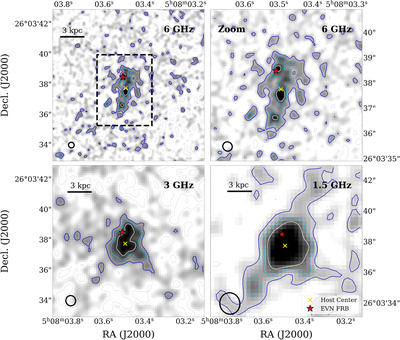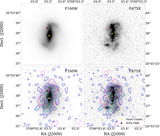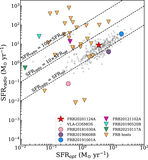Image Details

Caption: Figure 1.
VLA images with natural weighting of the host galaxy of FRB 20201124A taken in the extended A-array configuration in three bands: 6 GHz (top left; 10″ × 10″, top right; zoomed in, 6″ × 6″), 3 GHz (bottom left; 10″ × 10″), and 1.5 GHz (bottom right; 10″ × 10″). The beam size is displayed in the bottom left corner at each frequency. In each panel, the FRB position is represented as a red star, and the host centroid determined from HST imaging is marked as a yellow cross. Contours denote −2σ (dotted, gray), 2σ (dark blue), 4σ (light blue), and 6σ (white) significance levels, where σ = 13.95 μJy beam−1 at 1.5 GHz, 6.29 μJy beam−1 at 3 GHz, and 1.94 μJy beam−1 at 6 GHz. The radio emission is roughly aligned with the host center in all frequencies. While we are unable to resolve the smaller-scale structures at 1.5 and 3 GHz, the 6 GHz emission clearly exhibits complex morphology, with one peak located near the FRB position and another closer to the host galaxy center.
Copyright and Terms & Conditions
© 2024. The Author(s). Published by the American Astronomical Society.








